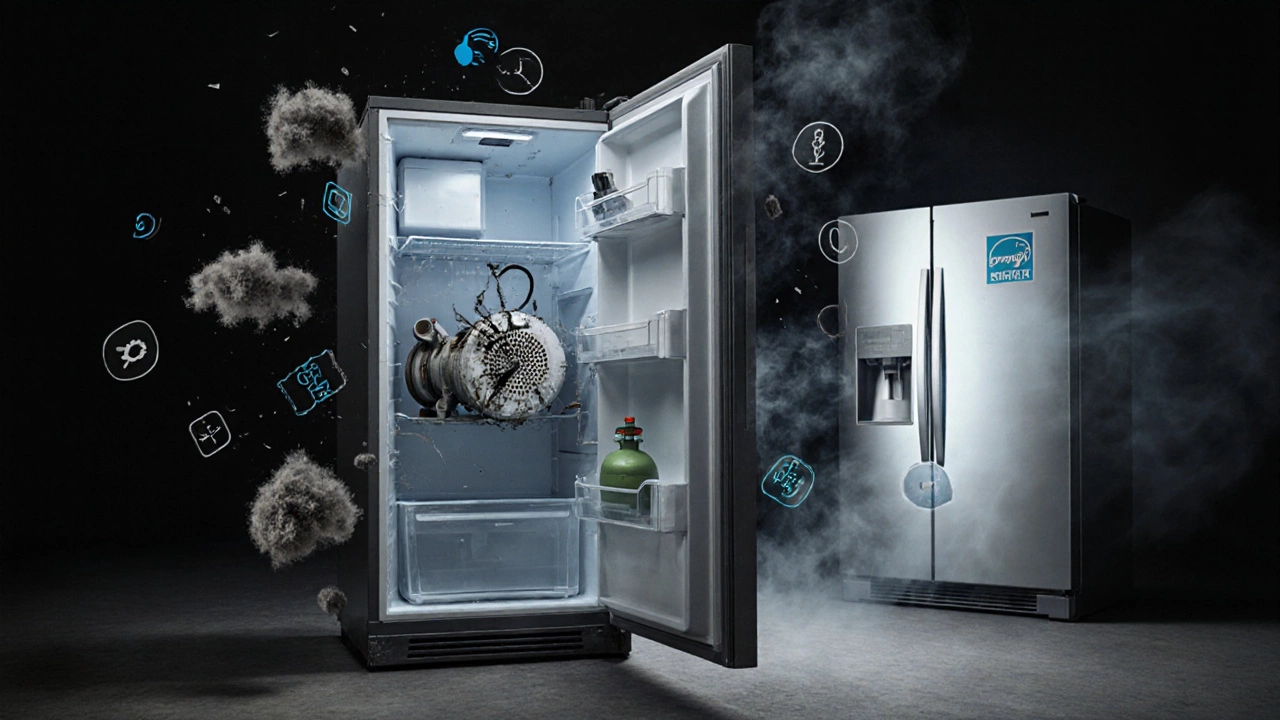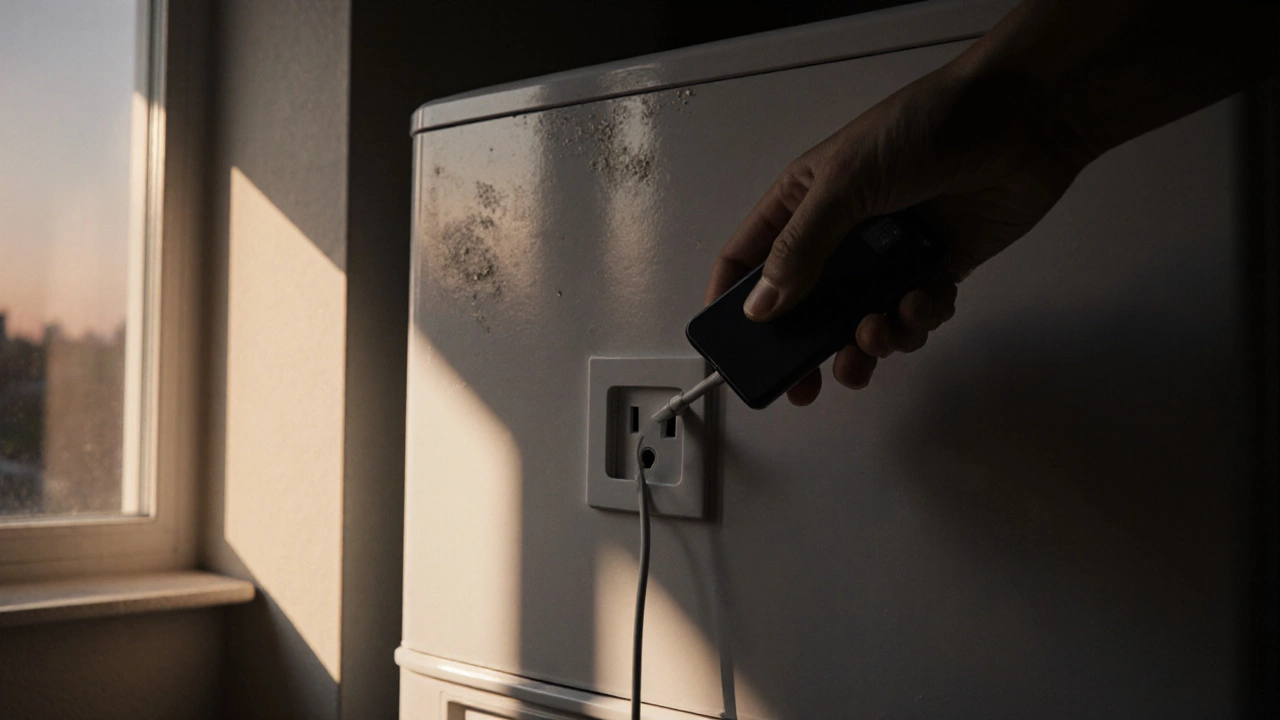Your fridge was humming along just fine yesterday, and now it’s silent. The light turns on, but the inside feels like a warm cupboard. No ice in the freezer. No cold air. You open the door and wonder - why would the fridge suddenly stop working? It’s not a slow decline. It’s a full stop. And it’s happening right now.
Power is the first thing to check - and it’s often the simplest fix
Before you panic or call a technician, unplug the fridge and plug it back in. Sounds basic? It is. But a loose outlet, a tripped GFCI, or a blown circuit breaker can kill power to the fridge without you noticing. In New Zealand homes, especially older ones, outlets in the kitchen are often on shared circuits. If someone turned on a kettle, toaster, or microwave at the same time, it could’ve overloaded the circuit. Check the breaker panel. Look for any switch that’s halfway between on and off. Flip it fully off, then back on. Then test the outlet with another device - like a phone charger. If nothing works, try a different outlet with an extension cord. If the fridge starts up there, your wall outlet is the problem.
The compressor is the heart - and it can fail without warning
If the fridge has power but makes no noise at all, the compressor might be dead. This is one of the most common reasons a fridge stops working suddenly. The compressor is what circulates refrigerant through the coils. Without it, there’s no cooling. Compressors don’t usually wear out slowly. They can die in seconds from a power surge, a manufacturing flaw, or just age. If your fridge is over 10 years old, this is a likely culprit. You might hear a faint click when you plug it in - that’s the start relay trying and failing to kick the compressor on. Replacing a compressor costs more than half the price of a new fridge. If your unit is older than 8-10 years, it’s often not worth repairing.
Dirty condenser coils are a silent killer
Most people don’t realize their fridge has coils on the back or underneath that need cleaning. These coils release heat from inside the fridge. When they’re covered in dust, pet hair, or kitchen grease, the fridge can’t cool properly. It runs non-stop, overheats, and eventually shuts down to protect itself. This isn’t a slow leak - it’s a sudden shutdown after weeks of straining. In Wellington’s damp climate, dust and lint cling to coils faster than in drier areas. Pull the fridge out from the wall. Vacuum the coils with a brush attachment. Do this every six months. If the fridge starts cooling again after cleaning, you just saved yourself a repair bill.
Thermostat or control board failure - the brain is broken
Modern fridges use digital control boards instead of simple dials. If the thermostat or control board fails, it might stop sending the signal to turn the compressor on. You’ll see the lights on the display working, the fan running, but no cold air. The fridge thinks it’s already cold. This often happens after a power surge or moisture buildup. If your fridge has a digital display showing temperature, but the inside isn’t cooling, the control board is suspect. You can’t test it yourself. A technician will need to check voltage signals and run diagnostics. It’s not a DIY fix. But it’s cheaper than replacing the compressor - if the fridge is under 7 years old.

Defrost system failure - ice builds up and blocks airflow
If your freezer is full of ice and the fridge is warm, the defrost system has failed. A small heater, timer, or sensor keeps the freezer coils from freezing solid. When it breaks, ice builds up around the evaporator fan and blocks cold air from reaching the fridge compartment. The fridge doesn’t stop working - it just can’t deliver cold air. You’ll find frost piled up behind the back panel in the freezer. You can temporarily fix this by unplugging the fridge, removing everything, and letting it thaw for 24 hours. If it cools again after that, the defrost system is the issue. Replacing the defrost heater or thermostat costs under $150 in parts. But if it fails again in six months, the control board is likely the root cause.
Refrigerant leak - rare, but serious
A refrigerant leak is the worst-case scenario. It’s rare, but it happens. If your fridge is completely warm and the compressor is running constantly, but the coils on the back aren’t warm to the touch, refrigerant may have leaked out. This isn’t something you can top up like oil in a car. The leak must be found, sealed, and the system recharged. It’s expensive. And if the fridge is older than 8 years, the refrigerant (R134a or R600a) is being phased out. Parts are scarce. Labor is high. In most cases, replacing the fridge is the smarter move. Don’t waste money chasing a leak in an old unit.
What to do next - step by step
Here’s what to do when your fridge stops working:
- Check the power: Plug something else into the same outlet. Check the breaker.
- Listen: Is the compressor humming? If not, it might be dead.
- Feel the back: Are the coils dusty? Clean them with a vacuum brush.
- Check the freezer: Is it full of ice? Defrost it completely.
- Wait 24 hours: After cleaning or defrosting, give it time to cool down.
- If none of that works: Call a licensed appliance technician. Don’t guess.
Don’t try to recharge refrigerant yourself. Don’t bypass safety switches. Don’t ignore strange smells or buzzing - those are signs of electrical issues that could start a fire.

When to repair - and when to replace
Here’s a quick rule: if your fridge is older than 10 years and the repair costs more than half the price of a new one, replace it. New fridges use 40-50% less energy. A modern A+++ model in New Zealand costs around $800-$1,200. It’ll pay for itself in electricity savings within 3-4 years. Plus, you’ll get better temperature control, quieter operation, and smart features like alerts if the door’s left open.
Also, consider this: if your fridge is 7-10 years old and needs a control board or compressor, you’re likely to need another repair in 1-2 years. One big repair now doesn’t mean long-term reliability. It means you’re just delaying the inevitable.
Prevent this from happening again
Keep your fridge healthy:
- Clean the coils every six months.
- Don’t overload the fridge - air needs to circulate.
- Keep the door seals clean and check for gaps - a torn seal lets cold air escape.
- Use a surge protector for your fridge. Power spikes from storms or grid fluctuations are a top cause of sudden failures.
- Don’t set the temperature below 2°C in the fridge or below -18°C in the freezer. Too cold strains the system.
Most fridge failures aren’t mysterious. They’re preventable. But they happen fast - and when they do, you’re left with spoiled food and a hot kitchen. Acting quickly saves money, time, and groceries.
Why is my fridge running but not cooling?
If the fridge is running but not cooling, the evaporator fan or defrost system is likely blocked by ice. Check the freezer for heavy frost buildup. If it’s frozen solid, unplug the fridge and let it thaw for 24 hours. If it cools after that, the defrost heater or thermostat needs replacing. Another possibility is a dirty condenser coil - clean the coils on the back or bottom of the fridge.
Can a power surge kill a fridge compressor?
Yes. A power surge - from a lightning strike, faulty wiring, or even a neighbor turning on a large appliance - can fry the compressor’s internal windings or the start relay. This is why it’s smart to plug your fridge into a surge protector. Older fridges without built-in surge protection are especially vulnerable. If your fridge stopped working right after a storm or power flicker, a surge is the likely cause.
Is it worth repairing a 12-year-old fridge?
Usually not. A 12-year-old fridge is past its average lifespan of 10-13 years. Even if you fix one part, another will likely fail soon after. Newer models use 40-50% less electricity. You’ll save $150-$250 a year on power bills. Plus, modern fridges have better temperature control, quieter operation, and features like door alarms. Spending $600-$800 on a repair for a 12-year-old fridge rarely makes financial sense.
What does it mean if my fridge clicks but doesn’t start?
A clicking sound usually means the start relay is trying to engage the compressor but failing. This can be caused by a bad relay, a weak capacitor, or a compressor that’s seized. Replacing the start relay is a cheap fix - under $30. But if the compressor itself is failing, replacing the relay won’t help. If the clicking continues after swapping the relay, the compressor is likely dead.
How long should I wait after unplugging my fridge before plugging it back in?
Wait at least 15 minutes. This lets the refrigerant pressure equalize inside the system. If you plug it back in too soon, the compressor could be damaged by trying to start under high pressure. For defrosting or major repairs, wait 24 hours to ensure all ice has melted and the system is dry. Rushing this step can cause more damage.
Next steps if your fridge won’t cool
If you’ve tried the basic checks - power, coils, defrost - and it still won’t cool, call a licensed appliance technician. Don’t delay. Spoiled food adds up fast. In Wellington, many local repair services offer same-day or next-day service. Ask if they charge a diagnostic fee and whether it’s waived if you go ahead with the repair. Get a written quote before they start. Avoid anyone who says, “I’ll just replace the compressor” without testing first. A good technician will run a full diagnostic - checking voltage, refrigerant levels, and component function - before giving you a price.
And if you’re thinking about replacing it - look for ENERGY STAR-rated models. They’re required to use at least 15% less energy than the federal standard. In New Zealand, brands like LG, Samsung, and Fisher & Paykel offer reliable, energy-efficient fridges with good warranty coverage. A new fridge isn’t just a replacement. It’s an investment in your kitchen, your wallet, and your peace of mind.

I am an expert in the services industry with a focus on appliance repair. My passion lies in understanding how things work and educating others in simple, engaging ways. This enthusiasm fuels my writing, where I delve into topics around appliance maintenance and troubleshooting. I aim to make these subjects clear and accessible to all readers.